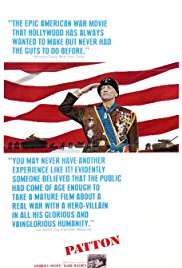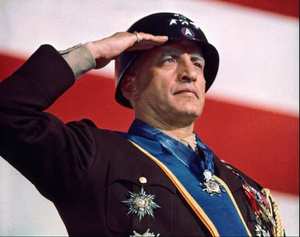PATTON
SUBJECTS — Biography; U.S./1941 – 1945;
SOCIAL-EMOTIONAL LEARNING — Leadership;
MORAL-ETHICAL EMPHASIS — Respect.
AGE: 12+ ; MPAA Rating — PG;
Drama; 1970; 171 minutes; Color. Available from Amazon.com.
There is NO AI content on this website. All content on TeachWithMovies.org has been written by human beings.

SUBJECTS — Biography; U.S./1941 – 1945;
SOCIAL-EMOTIONAL LEARNING — Leadership;
MORAL-ETHICAL EMPHASIS — Respect.
AGE: 12+ ; MPAA Rating — PG;
Drama; 1970; 171 minutes; Color. Available from Amazon.com.
TWM offers the following worksheets to keep students’ minds on the movie and direct them to the lessons that can be learned from the film.
Film Study Worksheet for a Work of Historical Fiction and
Worksheet for Cinematic and Theatrical Elements and Their Effects.
Teachers can modify the movie worksheets to fit the needs of each class. See also TWM’s Historical Fiction in Film Cross-Curricular Homework Project.
This film is a description of the military career and personality of General George S. Patton, Jr., one of the most effective and colorful U.S. Generals of WWII.
Selected Awards:
1970 Academy Awards: Best Picture, Best Director (Schaffner), Best Actor (Scott), Best Art Direction/Set Decoration, Best Film Editing, Best Sound, Best Story & Screenplay; 1970 Directors Guild of America Award: Best Director (Schaffner); 1971 Golden Globe Awards: Best Actor-Drama (Scott); National Board of Review Awards: Ten Best Films of the Year; Best Actor (Scott), 1970 National Society of Film Critics: Best Actor (Scott); 1970 Writers Guild of America: Best Original Screenplay; 1970 Academy Award Nominations: Best Cinematography, Best Original Score, Best Visual Effects. This film is ranked #89 on the American Film Institute’s List of the 100 Greatest American Movies of All Time (2006). This film is listed in the National Film Registry of the U.S. Library of Congress as a “culturally, historically or aesthetically significant” film.
Featured Actors:
George C. Scott, Karl Malden, Edward Binns, Stephen Young, Michael Strong, Frank Latimore, James Edwards, Lawrence Dobkin, John Doucette, Michael Bates, Tim Considine.
Director:
Franklin J. Schaffner.
“Patton” will introduce children to Generals Patton, Bradley and Rommel. It shows a brilliant and effective soldier who had trouble being, as all great generals must, a diplomat as well as a fighter. The makers of this film tried to provide an accurate portrayal of General Patton, consulting historical texts and interviewing people who served with him. They received a confidential letter from President Eisenhower, Patton’s superior during the war, who knew when to hold Patton back and when to unleash him. George C. Scott gives a masterful performance as Patton. One officer who served on Patton’s staff said, after viewing the movie, said, “. . . I thought it was the old man himself.”
MODERATE. This film glosses over a number of Patton’s serious problems as a general and as a human being (see Helpful Background section). There is a substantial amount of profanity in the film, shown as a symptom of what the film presents as Patton’s biggest problem, his inability to govern his tongue.
Before watching the film, briefly describe General Patton and the highlights of his career. See Helpful Background. Immediately after the movie, or at odd times over the next week (for example at the dinner table or in the car on the way to school) bring up some of the Discussion Questions, starting with the Quick Discussion Question below. Don’t worry if you can only get through a few questions. Just taking the film seriously and discussing it is the key. Allow your child to watch the movie several times and continue to bring up discussion questions relating to the film.

George S. Patton, Jr. (1885 – 1945) was probably the best tank commander of all time, but there were other generals who were better at the hard, gritty fighting needed to break through strong enemy defenses.
Many Americans, from GIs subjected to a “vainglorious Patton harangue” to Eleanor Roosevelt, had justifiably low opinions of “old blood and guts.” In addition to the problems with Patton described in the film: (1) Patton needlessly sacrificed the lives of his men not only to beat Montgomery to Messina but also in March of 1945 when he attempted to free his son-in-law from a prisoner of war camp deep in enemy territory. This endeavor, motivated by personal concerns, was unsuccessful, reckless and foolhardy. Patton’s son-in-law was seriously wounded in the raid but not freed. (2) Patton was anti-Semitic. (3) After the war, as military governor of Bavaria, Patton failed to implement the Army’s de-Nazification program. (4) Patton thought that General Dwight Eisenhower (who was his friend and who often intervened to protect him) was “yellow.” (5) Patton’s expressed hatred of the Russians (at that time our ally and the country which had suffered far more casualties and greater destruction from Nazi aggression than any other), while prophetic, caused serious diplomatic problems. (6) Patton would subject his troops to ranting tirades. A child being shown this film should be warned that General Patton had problems not fully elaborated in the movie.
Whatever his deficiencies, General Patton was a unique asset to the war effort. Despite a few lapses, he cared for his men and was affectionate with the people on his immediate staff. He was also genuinely religious and he was courteous to women. Many soldiers who served under him love the memory of General Patton. He inspired them and led them to victory. See the web page for The Patton Society. Note also that the rivalry between Patton and General George Montgomery was part of the rivalry between the U.S. Army and the British Army.
Patton received his first taste of combat in 1916 as a cavalry officer under General John J. Pershing on a punitive raid to Mexico. During the First World War, he was placed in command of the U.S. Tank Corps and was shot in the leg leading a tank charge on foot. When the Second World War neared, Patton was placed in charge of training tank commanders. At this post, Patton developed tactics that he used in North Africa. Patton practiced the motto “When in doubt: ATTACK!”
The Commander of Allied Forces in Europe, Dwight D. Eisenhower (later President of the United States) considered Patton his friend despite their many differences of opinion. Eisenhower saw Patton as a volatile character with a trait of exhibitionism who was not as good as other U.S. generals at the heavy fighting necessary to break through enemy concentrations. For this reason, Eisenhower did not use Patton in the slugging match with the Germans necessary for the Allies to break out of the beachhead at Normandy. But Eisenhower properly regarded Patton as a headstrong and fearless master of the fast and overwhelming pursuit. For that reason, once the Allies had broken through in Normandy, Eisenhower put Patton’s Third Army in the forefront.
Eisenhower advanced General Omar Bradley over Patton because Eisenhower considered Bradley to be outstanding in every aspect of command and a master of every military maneuver. Bradley did not seek to dramatize himself.
This film was intended to be, and in large part is, a serious study of Patton’s record and character. A bit of trivia demonstrates this. George C. Scott made an in-depth study of Patton in order to play the role. He believed that one scene in which Patton threatened to relieve one of his officers of command when the officer protested a particularly risky operation was too harsh. Scott believed that the scene suggested that Patton was indifferent to his men’s welfare. Scott protested the scene but the studio owners wouldn’t change it. Because General Patton had never been seen lying down in a combat situation, mentally or physically, Scott purposefully played the scene with Patton reclining on a couch, hoping that the audience would notice that it was false.
Patton and the Study of History:
In the movie, when Patton is flying from England into France after the Normandy Invasion. The book sitting on his lap is “The Norman Conquest of England” It tells how William the Conquerer developed a road infrastructure in Normandy to allow him to build a base of operations to invade England. When Patton is in in Africa, facing the German General Erwin Rommel, the Desert Fox, there is a scene in which he is awakened by his staff, the book Patton was reading when he fell asleep is a book by Rommel. Patton was trying to get into Rommel’s mind.
Great Patton Quotes:
“If the proper study of mankind is man. The proper study of warfare are maps.” [From Holien C-Span program]
“Wars may be fought with weapons, but they are won by men. It is the spirit of the men who follow and the man who leads that gains the victory.” [From D’Este Article]
1. See Discussion Questions for Use With any Film that is a Work of Fiction.
2. Should Patton have been disciplined for having slighted the Russians? They were our allies at the time.
1. Why would Patton have been a disaster as overall allied commander in Europe, the post in which Eisenhower was so effective?
Suggested Response:
Eisenhower had to be both a diplomat and a general to coordinate the armies of many nations.
2. What was difficult about Eisenhower’s job in the Second World War that was also different than commanding troops in battle?
3. Was Patton right to shoot the donkeys who were blocking the bridge?
4. Why was General Eisenhower outraged when Patton slapped the shell shocked soldier? (In fact, he slapped two soldiers.)
Discussion Questions Relating to Ethical Issues will facilitate the use of this film to teach ethical principles and critical viewing. Additional questions are set out below.
(Treat others with respect; follow the Golden Rule; Be tolerant of differences; Use good manners, not bad language; Be considerate of the feelings of others; Don’t threaten, hit or hurt anyone; Deal peacefully with anger, insults, and disagreements)
1. Patton violated each of the subcategories of the Respect Pillar of Character. Perhaps this is one explanation of why he was disliked by so many people. But can you explain why he was admired by so many others despite his actions in almost totally ignoring this Pillar?
In addition to websites which may be linked in the Guide and selected film reviews listed on the Movie Review Query Engine, the following resources were consulted in the preparation of this Learning Guide:
This Learning Guide was last updated on August 1, 2022.
Quotation from Army Historian, Kim Holein (Ret.) speaking on “Generals Patton & Rommel and D-Day” C-Span, June 2, 2022
* we respect your privacy. no spam here!